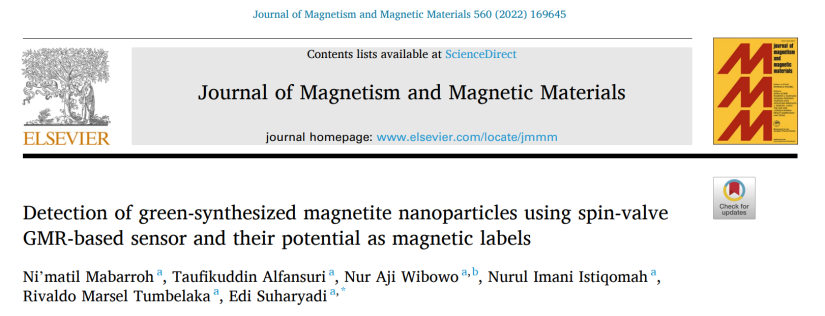
Ni’matil Mabarroh, Taufikuddin Alfansuri, Nur Aji Wibowo, Nurul Imani Istiqomah, Rivaldo Marsel Tumbelaka, Edi Suharyadi
https://doi.org/10.1016/j.jmmm.2022.169645
Journal of Magnetism and Magnetic Materials
Volume 560, October 2022, 169645
Abstract
Exploration of magnetic nanoparticle labels for giant magnetoresistance (GMR) biosensing technology is crucial because their characteristics determine GMR-based sensor performance, related to their stray field and compatibility to biomolecule. We investigated the potency of the green-synthesized magnetite (Fe3O4) nanoparticle as a green-magnetic label on a spin-valve (SV) GMR sensor based on a [Ta (2 nm)/Ir20Mn80 (10 nm)/Co90Fe10 (3 nm)/Cu (2.2 nm)/(Co84Fe10B4 (10 nm)/Ta (5 nm)] structure that generated a 7.3 Oe exchange-bias field and 5.73% magnetoresistance. Fe3O4 nanoparticles were synthesized by a chemical coprecipitation method utilizing Moringa oleifera (MO) leaf extract as a natural reducing agent. The green-synthesized Fe3O4 nanoparticles exhibited a cubic inverse spinel structure as a pristine Fe3O4 characteristic. The crystallite size of green-synthesized Fe3O4 was larger than that of Fe3O4, reaching ∼ 14 nm, and formed a particle size of 29.1 nm. Its magnetic properties included soft ferromagnetic behavior with 55.5 emu/g saturation magnetization and 54 Oe coercivity; its saturation was lower than that of Fe3O4 due to the presence of the phytochemical compound of MO extract. In addition, to observe its potency as a magnetic label for biosensing, conventionally synthesized nanoparticles, surface modification using polyethylene glycol (PEG), and attachment of an α-amylase enzyme as a biomarker sample on green nanoparticle labels were also investigated. When measuring various concentration labels using the SV-GMR thin film, the green-synthesized Fe3O4 achieved a linear relationship and a better sensitivity of 0.098 mV/mg/mL than that of the conventional compound. The sensor could detect Fe3O4-labelled α-amylase enzyme as indicated by the decreasing output voltage, a consequence of altering the surface conditions of the nanoparticles. Therefore, green-synthesized nanoparticles are reliable and achieve competitive performance as magnetic labels in GMR sensors.
